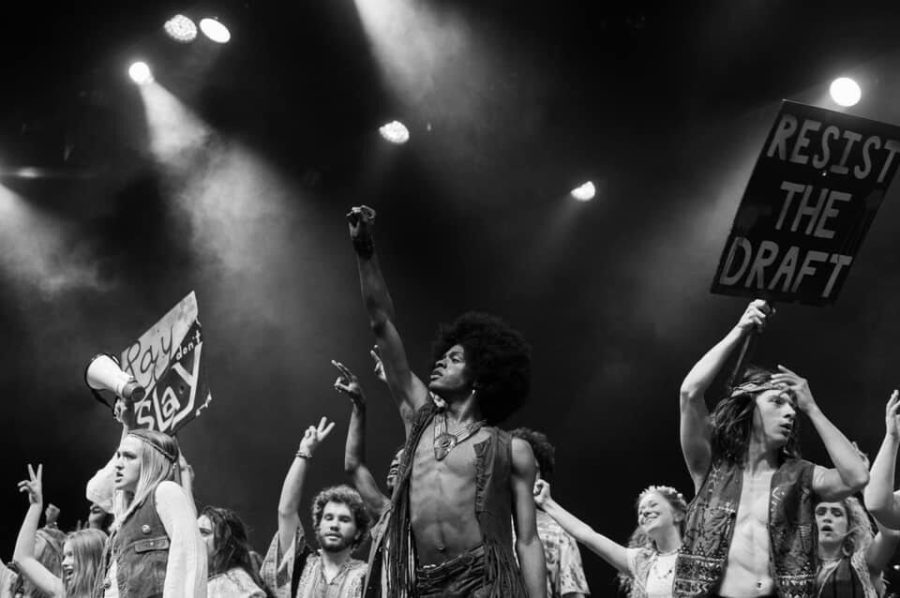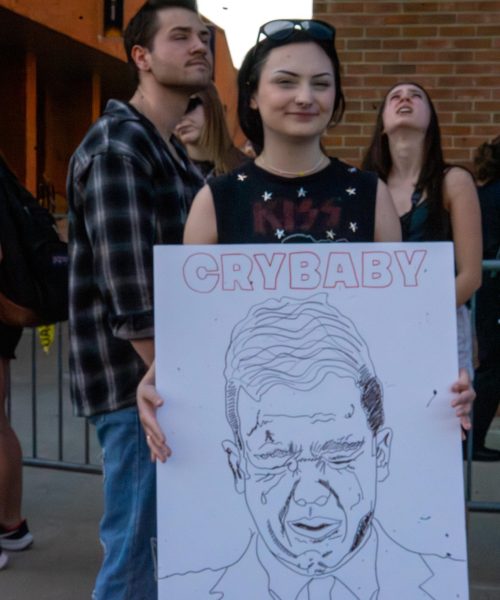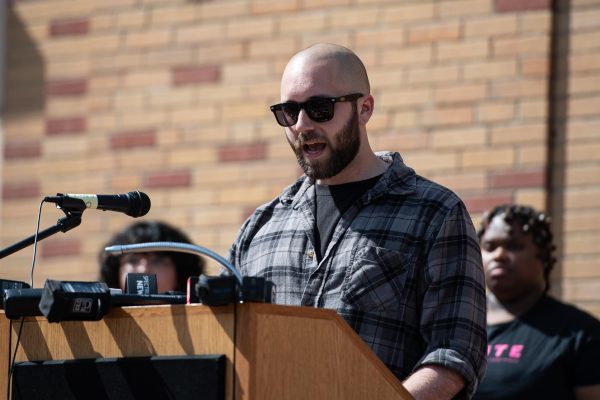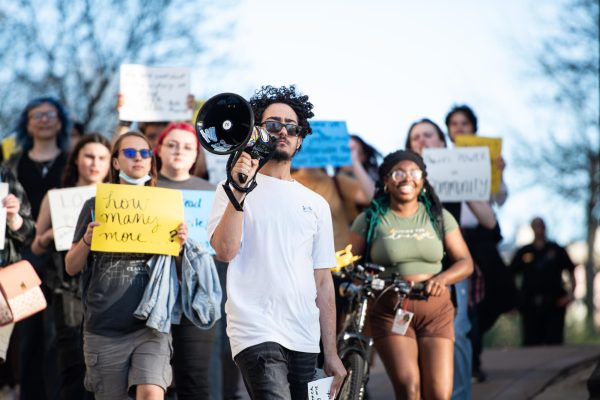Theatre students call for inclusion and representation in petition
June 6, 2020
Inspired by the recent surge in support for the Black Lives Matter movement, Kent State’s Black Theatre Association created a petition to ensure equal representation and opportunity for students of color within the School of Theatre and Dance.
“We’ve had this in the works for a while, but with everything that’s going on, we’ve been especially inspired to fight harder and do something about the injustice that’s circulating around the country,” said Sunayna Smith, a senior theater studies major and the vice president of BTA. “Everyone’s waking up, the Black Lives Matter movement has had such an impact, so we just thought, ‘there’s no better day than today.’”
The petition includes eight points, including a call for representation for students of color when selecting the school’s annual performance season and roles that call for a specific race or ethnicity to be cast accordingly.
Senior musical theatre major and BTA President Jaye Jackson helped write the petition. His hope is that changes are made not out of requirement, but from a desire to grow and learn.
“We challenged the faculty to really educate themselves because they want to educate themselves, because they want to be better for our students and because they want us to feel comfortable being in their spaces,” Jackson said. “It’s not just about black students, it’s about all students of color being treated with respect.”
The School of Theatre and Dance’s twitter account posted a statement standing with students of color, in part saying,“We affirm the value, courage & brilliance of all members of the African American community & commit to uphold the values of peaceful protest, hear the discord, & support institutional changes to honor diversity & protect all lives from discrimination, injustice & violence.”
“For years now, they’ve told us they were going to change things, and they didn’t,” Jackson said. “I’m only calling attention to these issues because they’re important, and I know that they can do better. Kent State has been a great school to me. I love all the faculty so much. I love all the students so much. I love our community so much — but we need to change things for ourselves.”
The petition was created on June 1 and now has over 840 signatures — including that of Eric van Baars, the director of the School of Theatre and Dance. He was eager to see students taking action.
“I signed it pretty much right after I read it,” van Baars said. “It’s like, who wouldn’t agree? Why would I not agree to these things? They’re all positive values and things that can be fully explored and achieved in the school.”
Several faculty members from the School of Theatre and Dance pledged their commitment to make “the actor training at Kent State University anti-racist” in an email to students on June 5, saying in part, “We acknowledge that striving to be anti-racist must be intentional and unceasing, and we are committed to implementing anti-racist ideas, policies and teaching in our classes and mentoring.”
“There’s a commitment from the school, from myself, to address concerns and make not only the school, but the policies in the school more open and more positive for underrepresented students and students of color, because we’ve realized that there’s always more work to do on that front,” van Baars said.
The School of Theatre and Dance previously faced controversy in 2018 when black and white students were cast in lead roles in “West Side Story” — roles meant to be played by Latinx people.
“We were all upset because as black students, it’s not our story to tell,” said Jackson. “Throwing us in that category of all the ‘people of color’ just, like, black or Latinx or whatever, was just not fair.”
Jackson said this isn’t the first time he has felt that minority students were being misrepresented. Even in shows that include black and POC characters, Jackson said the roles students of color are cast in often perpetuate harmful stereotypes.
“In ‘The Mystery of Edwin Drood,’ there are two characters from India, and they were both played by black people,” said Jackson. “In ‘Parade,’ there’s three or four black characters who are these really stereotypical black character types. So that’s our only representation on stage. They don’t mean for it to be racist, but it is because these are the stereotypes and racist behaviors that preceded us.”
Jackson played Hud in the school’s production of “Hair” in fall 2019 — much of the character’s dialogue is about being a black man in 1960’s America, including the usage of racial slurs.
“For me personally, it was a battle because yes, I want to play this character who is standing up on stage and being proud to be black and taking those words back,” Jackson said. “But at the same time, I’m doing so with a bunch of white kids in front of a mostly white audience. They might not understand the point of me trying to reclaim my role as a black man and just see me literally calling myself the n-word. So even if we get parts, it can still be difficult.”
Smith said that students of color in the program often set their expectations low when cast lists come out, citing a lack of positively-portrayed parts written specifically for students of color.
“When we find out the shows we’ll say, ‘So, there’s two black people in this show or an ethnically-ambiguous part — OK, so I’ll get a callback for this part, or I won’t get a role at all,’” Smith said. “It’s like, cast it based on my talent, not based on my skin color.”
Beyond the struggle to feel represented by roles and shows performed at the school, Smith said racial insensitivity is prevalent in the classroom as well.
“It could be something so small, a passing comment or note, but it’ll stick with a student forever,” Smith said. “I don’t think a lot of educators see that. Even if that comment isn’t meant to be harmful, it is. But I’m about the positive, and finding ways to teach and change.”
Smith said some faculty members are already working to improve representation for students of color. In “Parade,” Smith played ‘Angela,’ a part usually represented as a slave or servant to the mayor of Marietta, Georgia. According to Smith, the show’s director Fabio Polanco told Smith and her scene partner Will Gibson they would be playing middle-class black people commenting on the status of the Leo Frank case through a black lens.
“That was the first time that the director had actually taken something that’s kind of uncomfortable and made it better,” Smith said.“And I think so many more educators should put that mindset into practice and take a negatively-portrayed black role and adapt it like that.”
Issues of race and representation in theatre stretch far beyond Kent State’s program. 2016 was a historic year for Broadway, with the diverse-cast of “Hamilton” sweeping 11 Tony Award categories and all four major acting category wins going to actors of color. But an AAPAC report showed in the season following the premiere of “Hamilton,” the representation for people of color on Broadway dropped from 36 percent to 29 percent.
“These are conversations that have been happening in theater companies since I was young,” van Baars said. “Look at colorblind casting and rules and sanctions and concepts that have led through that pain to where we are today, to really looking at representation and authenticity in our communities and in our art.”
Of the 37 works in the 2019-2020 Broadway season, only four showcased playwrights of color — and eight shows cast no artists of color whatsoever.
But beyond Broadway, diverse playwrights across the country are starting to gain more recognition for their artistry. According to American Theatre Magazine, six of the 22 most-produced playwrights across the country last year were playwrights of color, including the list’s first Native American, or indigenous, playwright. The diversification of the theatre landscape across the country is starting small with community and regional theatres, but Smith believes that is the best route to change.
“Let’s start right here on campus and create a positive awareness into the injustices we face,” Smith said. “What’s been great about all of this is that people are starting to see the problems right in front of them, the problems we can manage and fix right here and right now.”
The Black Theatre Association hosted a Zoom town hall meeting with the School of Theatre and Dance community on June 6. Van Baars said his goal moving forward is simply to listen to students’ concerns and make the changes they need to see the most.
“I want to hear from the voices in the school and multiple perspectives,” van Baars said. “It’s so good to be in conversation with people, and that’s what I’m looking forward to the most, but before we take action, we have to do the listening.”
Smith and Jackson both said they are grateful for the faculty’s willingness to continue the dialogue about representation for students of color at the school.
“Not many other schools would have given the students a chance to create a petition like this or even to address their concerns, so we’re glad to have the opportunity to start a conversation,” Smith said.
“This is not like a one-day thing, you know. A lot of people sign a petition and they feel like that’s enough,” Jackson said. “We have to continue to have people standing with us all the way through. This education process and this fight needs to go beyond that — people really need to, today and for eternity, educate themselves and stand with your people of color, because they need you.”
For more information about BTA, visit their Instagram account.
Contact Maddy Haberberger at [email protected].
























